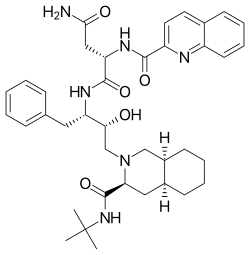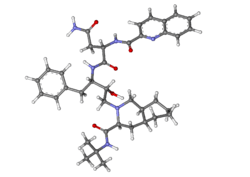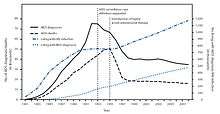Saquinavir
Saquinavir, sold under the brand names Invirase and Fortovase, is an antiretroviral drug used together with other medications to treat or prevent HIV/AIDS.[2] Typically it is used with ritonavir or lopinavir/ritonavir to increase its effect.[2] It is taken by mouth.[2]
 | |
 | |
| Clinical data | |
|---|---|
| Trade names | Invirase, Fortovase |
| AHFS/Drugs.com | Monograph |
| MedlinePlus | a696001 |
| License data | |
| Pregnancy category |
|
| ATC code | |
| Pharmacokinetic data | |
| Bioavailability | ~4% (without ritonavir boosting)[1] |
| Protein binding | 98% |
| Metabolism | Hepatic, mainly by CYP3A4 |
| Elimination half-life | 9–15 hours |
| Excretion | feces (81%) and urine (3%) |
| Identifiers | |
IUPAC name
| |
| CAS Number | |
| PubChem CID | |
| IUPHAR/BPS | |
| DrugBank | |
| ChemSpider | |
| UNII | |
| KEGG | |
| ChEMBL | |
| NIAID ChemDB | |
| CompTox Dashboard (EPA) | |
| Chemical and physical data | |
| Formula | C38H50N6O5 |
| Molar mass | 670.841 g/mol g·mol−1 |
| 3D model (JSmol) | |
SMILES
| |
InChI
| |
| (verify) | |
Common side effects include nausea, vomiting, diarrhea, and feeling tired.[2] More serious side effects include problems with QT prolongation, heart block, high blood lipids, and liver problems.[2] It appears to be safe in pregnancy.[2] It is in the protease inhibitor class and works by blocking the HIV protease.[2]
Saquinavir was patented in 1988 and first sold in 1995.[3][4] As of 2015 it is not available as a generic medication in the United States and is expensive.[5] The wholesale cost in the developing world is about 4.50 USD per day.[6]
Medical uses
Saquinavir is used together with other medications to treat or prevent HIV/AIDS.[2] Typically it is used with ritonavir or lopinavir/ritonavir to increase its effect.[2]
Side effects
The most frequent adverse events with saquinavir in either formulation are mild gastrointestinal symptoms, including diarrhea, nausea, loose stools & abdominal discomfort. Invirase is better tolerated than Fortovase.
Bioavailability and drug interactions
Saquinavir, in the Invirase formulation, has a low and variable oral bioavailability, when given alone. The Fortovase formulation at the standard dosage delivers approximately eightfold more active drug than Invirase, also at the standard dosage.[7]
In the clinic, it was found that the oral bioavailability of saquinavir in both formulations significantly increases when patients also receive the PI ritonavir. For patients, this has the major benefit that they can take less saquinavir, while maintaining sufficient saquinavir blood plasma levels to efficiently suppress the replication of HIV.
The mechanism behind this welcome observation was not directly known, but later it was determined that ritonavir inhibits the cytochrome P450 3A4 isozyme. Normally, this enzyme metabolizes saquinavir to an inactive form, but with the ritonavir inhibiting this enzyme, the saquinavir blood plasma levels increased considerably. Additionally, ritonavir also inhibits multidrug transporters, although to a much lower extent.
Unlike other protease inhibitors, the absorption of saquinavir seems to be improved by omeprazole.[8]
Mechanism of action
Saquinavir is a protease inhibitor. Proteases are enzymes that cleave protein molecules into smaller fragments. HIV protease is vital for both viral replication within the cell and release of mature viral particles from an infected cell. Saquinavir binds to the active site of the viral protease and prevents cleavage of viral polyproteins, preventing maturation of the virus. Saquinavir inhibits both HIV-1 and HIV-2 proteases.
History

Saquinavir was developed by the pharmaceutical company Roche. Saquinavir was the first protease inhibitor (and sixth antiretroviral) approved by the Food and Drug Administration (FDA). Within 2 years of its approval, and that of ritonavir 4 months later, annual deaths from AIDS in the United States fell from over 50,000 to approximately 18,000.[10] The manufacturer, Roche, requested and received approval of Invirase via the FDA's "Accelerated Approval" program, a process designed to speed drugs to market for the treatment of serious diseases. This decision was controversial, amid disagreement between AIDS activists over the benefits of thorough testing versus early access to new drugs.[11]
It was approved again on Nov 7, 1997 as Fortovase, a soft gel capsule reformulated for improved bioavailability. Roche announced in May 2005 that, owing to reduction in demand, Fortovase would cease being marketed early in 2006 in favour of Invirase boosted with ritonavir.[12]
Society and culture
Cost
As of 2015 it is not available as a generic medication and is expensive.[5] The wholesale cost is about 4.50 USD per day.[6]
Formulations
Two formulations have been marketed:
- a hard-gel capsule formulation of the mesylate, with trade name Invirase, which requires combination with ritonavir to increase the saquinavir bioavailability;
- a soft-gel capsule formulation of saquinavir (microemulsion,[13] orally-administered formulation), with trade name Fortovase, which was discontinued worldwide in 2006.[14]
References
- "Invirase (saquinavir mesylate) Capsules and Tablets, for Oral Use. Full Prescribing Information" (PDF). Genentech, Inc. Archived (PDF) from the original on 24 November 2015. Retrieved 23 November 2015.
- "Saquinavir". The American Society of Health-System Pharmacists. Archived from the original on 2015-09-08. Retrieved Sep 5, 2015.
- Minor, Lisa K. (2006). Handbook of Assay Development in Drug Discovery. Hoboken: CRC Press. p. 117. ISBN 9781420015706. Archived from the original on 2016-03-31.
- Fischer, Jnos; Ganellin, C. Robin (2006). Analogue-based Drug Discovery. John Wiley & Sons. p. 509. ISBN 9783527607495.
- Hamilton, Richart (2015). Tarascon Pocket Pharmacopoeia 2015 Deluxe Lab-Coat Edition. Jones & Bartlett Learning. p. 72. ISBN 9781284057560.
- "Saquinavir". International Drug Price Indicator Guide. Retrieved 6 September 2015.
- FortovaseTM (saquinavir) soft gelatin capsules. Product information (November 1997)
- Winston A, Back D, Fletcher C, et al. (2006). "Effect of omeprazole on the pharmacokinetics of saquinavir-500 mg formulation with ritonavir in healthy male and female volunteers". AIDS. 20 (10): 1401–6. doi:10.1097/01.aids.0000233573.41597.8a. PMID 16791014.
- "www.cdc.gov" (PDF). Archived (PDF) from the original on 2015-09-24.
- "HIV Surveillance --- United States, 1981--2008". Archived from the original on 9 November 2013. Retrieved 8 November 2013.
- "Drugs! Drugs! Drugs! An Overview of the Approved Anti-HIV Medications". The Body. Archived from the original on 9 November 2013. Retrieved 20 February 2013.
- Withdrawal of Fortovase (PDF) Archived 2006-05-14 at the Wayback Machine
- Gibaud, S. P.; Attivi, D. (2012). "Microemulsions for oral administration and their therapeutic applications" (PDF). Expert Opinion on Drug Delivery. 9: 1. doi:10.1517/17425247.2012.694865. PMID 22663249.
- News-Medical.Net. May 18, 2005 Roche to discontinue the sale and distribution of Fortovase (saquinavir) Archived 2015-02-22 at the Wayback Machine
External links
- Saquinavir bound to proteins in the PDB